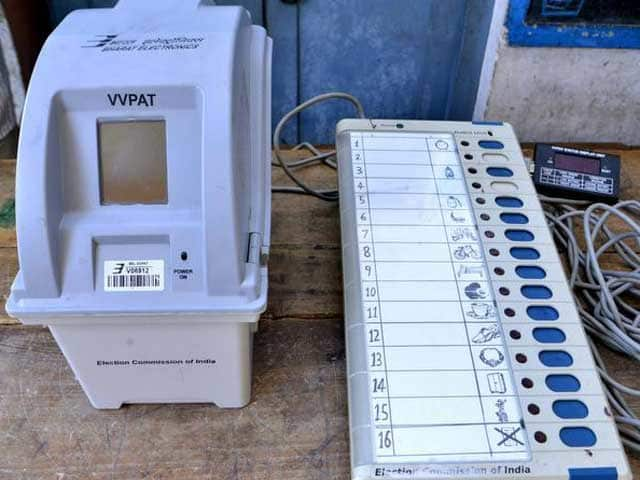
New Delhi:
In a significant development this morning – as the country votes in the second phase of the 2024 Lok Sabha election – the Supreme Court has given Electronic Voting Machines, or EVMs, a big vote of confidence. A two-judge bench rejected petitions seeking 100 per cent verification of votes cast on EVMs using the VVPAT, or Voter Verifiable Paper Audit Trail.
“We have discussed, elaborately, all protocols and technical aspects (and) we reject all pleas. Blindly distrusting a system can lead to unwarranted suspicions,” Justice Dipankar Datta and Justice Sanjiv Khanna said, while also rejecting a plea to return to paper ballots.
READ | Top Court Dismisses Requests Seeking 100% Verification Of Votes
The court did, however, pass two directions to the Election Commission in this regard.
Supreme Court’s Directions On VVPATs, EVMs
The first was that after completing loading of symbols into the machine, the SLU, or symbol loading unit, should be sealed and stored for a period of at least 45 days.
Specifically, the court said “on completion of symbol loading process in EVM, undertaken on or after June 1 (the final phase of polling), the SLU should be sealed and secured…”
The SLU storage containers must be sealed and the seal is to be signed by candidates.
“The sealed containers containing the SLUs shall be kept in storerooms, with the EVMs, (for) at least for 45 days post declaration of results,” the court explained.
READ | “Don’t Try To Bring Down System”: Top Court In VVPAT Case
The second was that the burnt memory in the EVM microcontroller EVM must be checked by a team of engineers – after results are declared – if candidates make such a request.
This request – which can be made by candidates placing second and third in the election – must be made within seven days of declaration of results, the court said.
The expenses for this verification will have to be borne by the candidate, the court also said. The cost will, however, be refunded if the EVM is found to have been tampered with.
READ | Top Court Asks If Voters Can Get VVPAT Slip, Poll Body Flags Big Risk
The Supreme Court also suggested the Election Commission explore the possibility of using a machine to count VVPAT slips. Currently, VVPAT slips of five randomly selected EVMs in every Assembly segment are verified.
VVPAT Directions
The VVPA is an independent system attached to the EVM that allows voters to check if their votes were cast as intended. When a vote is cast, a slip is printed containing the serial number, name and symbol of the candidate, and this is shown to the voter – from behind a transparent screen – for seven seconds, after which the machine stores it in a sealed box.
In the event of alleged discrepancies, the paper slips can be cross-checked against the votes recorded electronically to see if the declared result is, in fact, valid.
During the hearings, the poll panel explained that there is a 4MB flash memory in each VVPAT machine which stores the party symbols.
This unit, or the SLU, will be kept in locked storerooms with the EVMs, the court said.
EVM Unit Explained
An EVM has two units – the control unit and the voting unit.
These are linked by a cable. The control unit is with the polling officer while the voting unit is kept where people cast their votes and is usually covered on all sides for privacy.

Each major component of the EVM has its own microchip.
READ | Explained: How EVMs Record Your Vote, And How VVPAT System Works
Each microchip is a one-time programmable, or masked, chip, which cannot be overwritten, meaning the preloaded software cannot be reprogrammed in a particular manner.

Also, all EVMs are stand-alone machines that are not remotely via any network, and are not connected to any external devices. There is also no operating system, or OS, and, therefore, “absolutely no chance of programming EVMs to select a particular candidate or party”.
The VVPAT Case
The bunch of petitions before the court had sought a direction to cross-verify every vote cast on EVMs with paper slips generated by the VVPAT system. The court earlier said it was not the controlling authority for elections and could not dictate the functioning of the poll body, a constitutional authority. It had also wondered if it can act on mere suspicion.
Responding to concerns raised by Advocate Prashant Bhushan, appearing for petitioner Association for Democratic Reforms, the court said in the last hearing, “If you are predisposed about a thought-process, then we cannot help you… we are not here to change your thought process.
NDTV is now available on WhatsApp channels. Click on the link to get all the latest updates from NDTV on your chat.
Waiting for response to load…
| Denial of responsibility! Thelocalreport.in is an automatic aggregator around the global media. All the content are available free on Internet. We have just arranged it in one platform for educational purpose only. In each content, the hyperlink to the primary source is specified. All trademarks belong to their rightful owners, all materials to their authors. If you are the owner of the content and do not want us to publish your materials on our website, please contact us.The content will be deleted within 24 hours. |













